How Java Virtual Machine JVM works ?
Java Virtual Machine (JVM) is
a engine that provides runtime environment to drive the Java Code or
applications. It converts Java bytecode into machines language. JVM is a part
of Java Run Environment (JRE). In other programming languages, the compiler
produces machine code for a particular system. However, Java compiler produces
code
for a Virtual Machine known as Java Virtual Machine.
for a Virtual Machine known as Java Virtual Machine.
Here is how JVM works
First Java
source code converts in .class file . Which
load by the class loader in JVM JVM keep
the .class file in different
memory space allocated . Then execution
engine executes the class in machine level code. where then operating system gives output
after processing.
JVM Architecture
Class Loader
Subsystem
It is mainly responsible for three activities.
Loading
Linking
Initialization
Class loader diagram
Bootstrap ClassLoader:
The bootstrap class loader loads the
core Java libraries located in the /jre/lib directory
specifically loads rt.jar
This ClassLoader is written in a
native language which is C/C++.
Bootstrap is the parent ClassLoader
and Extension ClassLoader falls under it.
Extension ClassLoader:
It loads classes from the JDK
Extension located in the, /jre/lib/ext
Extension ClassLoader is implemented
by the sun.misc.Launcher$ExtClassLoader class.
System ClassLoader is the child of this ClassLoader.
System ClassLoader:
This loader is responsible for
loading the classes found on java classpath.
It is implemented by the sun.misc.Launcher$AppClassLoader class.
Setting the classpath through an
environment variable.
set CLASSPATH=D:\myprogram
java org.mypackage.HelloWorld
Linking : Performs verification, preparation,
and (optionally) resolution.
Verification : It ensures the
correctness of .class file i.e. it check
whether this file is properly formatted and generated by valid compiler or not.
If verification fails, we get run-time exception java.lang.VerifyError.
Preparation : JVM allocates memory for
class variables and initializing the memory to default values.
Resolution : It is the process of
replacing symbolic references from the type with direct references. It is done
by searching into method area to locate the referenced entity.
Initialization : In this phase, all static variables
are assigned with their values defined in
the code and static block(if any). This is executed from top to bottom in a class and from parent to child in class hierarchy. Initialization sets the actual variable values instead of the default values allotted during class preparation.
the code and static block(if any). This is executed from top to bottom in a class and from parent to child in class hierarchy. Initialization sets the actual variable values instead of the default values allotted during class preparation.
- Initialization of a class consists of two steps:
- Initializing the class’s direct superclass (if any), if the direct superclass hasn’t already been initialized.
- Executing the class’s class initialization method, if it has one.
- Initialization of an interface does not require initialization of its super interfaces. Just the interface’s interface initialization method is executed, if it has one.
JVM Memory
Method area :In method area, all class level information like class name, immediate parent class name, methods and variables information etc. are stored, including static variables. There is only one method area per JVM, and it is a shared resource.
Method area :In method area, all class level information like class name, immediate parent class name, methods and variables information etc. are stored, including static variables. There is only one method area per JVM, and it is a shared resource.
Heap area :Information of all objects is stored in heap area. There is also one Heap Area per JVM. It is also a shared resource.
Stack area :For every thread, JVM create one run-time stack which is stored here. Every block of this stack is called activation record/stack frame which store methods calls. All local variables of that method are stored in their corresponding frame. After a thread terminate, it’s run-time stack will be destroyed by JVM. It is not a shared resource.
PC Registers :Store address of current execution instruction of a thread. Obviously each thread has separate PC Registers.
Native method stacks :For every thread, separate native stack is created. It stores native method information.
How Java Virtual Machine JVM works ?
 Reviewed by Mukesh Jha
on
11:18 PM
Rating:
Reviewed by Mukesh Jha
on
11:18 PM
Rating:
 Reviewed by Mukesh Jha
on
11:18 PM
Rating:
Reviewed by Mukesh Jha
on
11:18 PM
Rating:









C581C838A1
ReplyDeleteGörüntülü Show Uygulamaları
Telegram Show
Görüntülü Sex Sohbet